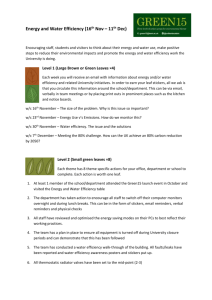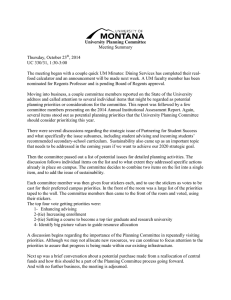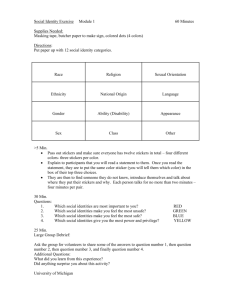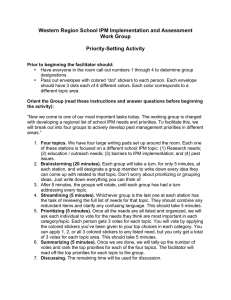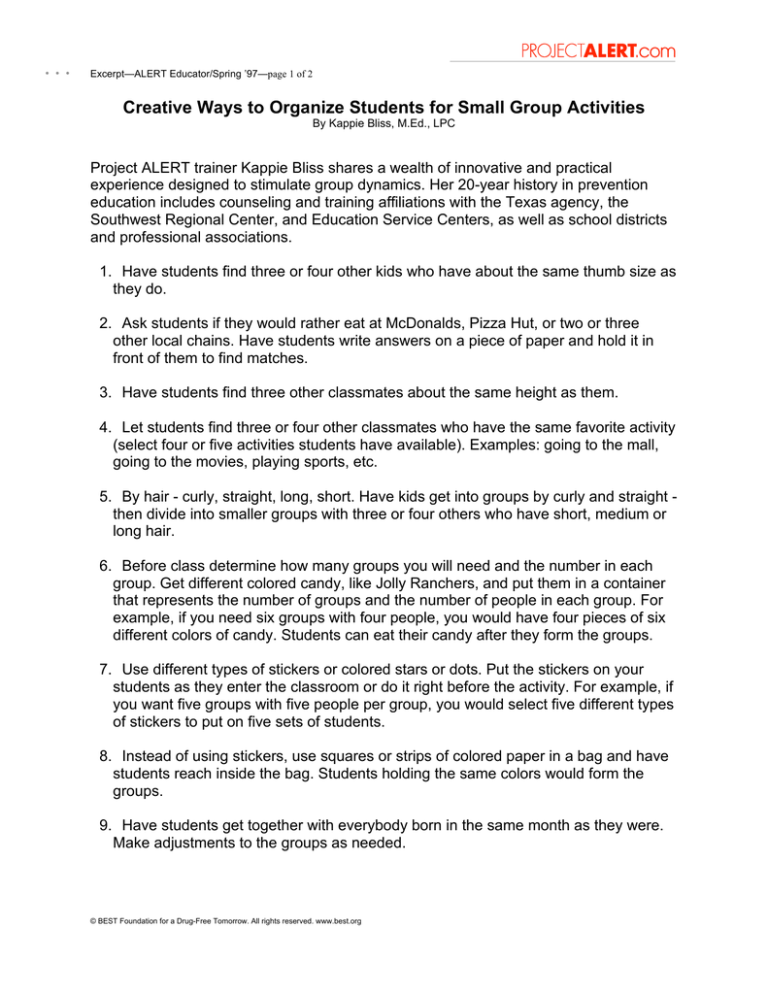
• • •
Excerpt—ALERT Educator/Spring ’97—page 1 of 2
Creative Ways to Organize Students for Small Group Activities
By Kappie Bliss, M.Ed., LPC
Project ALERT trainer Kappie Bliss shares a wealth of innovative and practical
experience designed to stimulate group dynamics. Her 20-year history in prevention
education includes counseling and training affiliations with the Texas agency, the
Southwest Regional Center, and Education Service Centers, as well as school districts
and professional associations.
1. Have students find three or four other kids who have about the same thumb size as
they do.
2. Ask students if they would rather eat at McDonalds, Pizza Hut, or two or three
other local chains. Have students write answers on a piece of paper and hold it in
front of them to find matches.
3. Have students find three other classmates about the same height as them.
4. Let students find three or four other classmates who have the same favorite activity
(select four or five activities students have available). Examples: going to the mall,
going to the movies, playing sports, etc.
5. By hair - curly, straight, long, short. Have kids get into groups by curly and straight then divide into smaller groups with three or four others who have short, medium or
long hair.
6. Before class determine how many groups you will need and the number in each
group. Get different colored candy, like Jolly Ranchers, and put them in a container
that represents the number of groups and the number of people in each group. For
example, if you need six groups with four people, you would have four pieces of six
different colors of candy. Students can eat their candy after they form the groups.
7. Use different types of stickers or colored stars or dots. Put the stickers on your
students as they enter the classroom or do it right before the activity. For example, if
you want five groups with five people per group, you would select five different types
of stickers to put on five sets of students.
8. Instead of using stickers, use squares or strips of colored paper in a bag and have
students reach inside the bag. Students holding the same colors would form the
groups.
9. Have students get together with everybody born in the same month as they were.
Make adjustments to the groups as needed.
© BEST Foundation for a Drug-Free Tomorrow. All rights reserved. www.best.org
• • •
Excerpt—ALERT Educator/Spring ’97—page 2 of 2
10. Have students close either their left eye or right eye and keep it closed. Find three
other people who have the same eye closed.
11. Ask students if they are wearing a belt. Then get together with three other people
who are, or are not, wearing a belt.
12. Have students get into groups of four or five with others who are wearing at least
one item of the same color as something they have on.
13. Ask students to count up the letters in their first name and determine if they have
an odd number of letters or an even number of letters. Find three or four others who
also have an even or odd number of letters in their name and form a group.
14. Ask students if they would rather be eating an apple, banana, peach, strawberry or
plum. Get together in small groups of four or five with people who picked the same
fruit.
15. Number off.
16. Go around the room repeating one word of a school chant, like "Let's go, Cubs!" or
"We're Number One!" Everyone who said "Let's" on their turn is in one group. All the
"go's" are in another, and the "Cubs" are in the third group.
© BEST Foundation for a Drug-Free Tomorrow. All rights reserved. www.best.org

